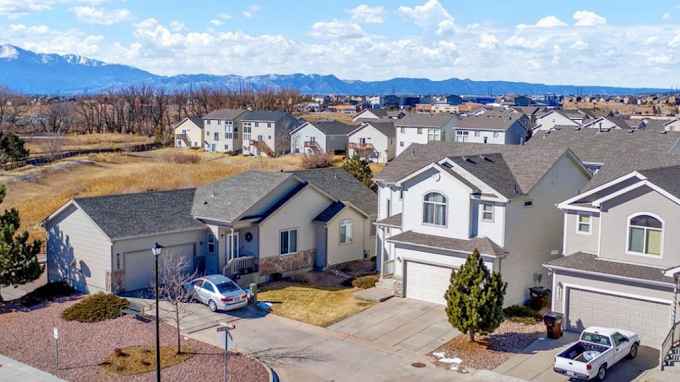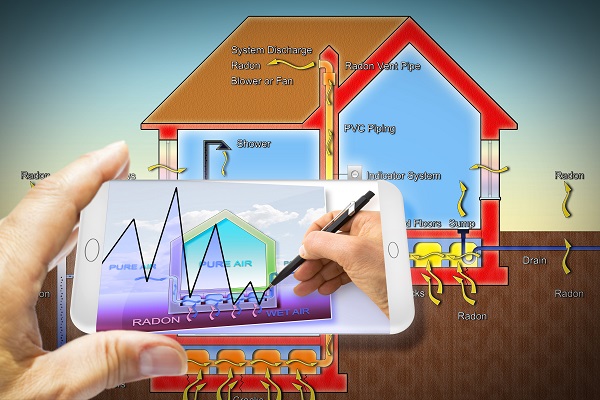Radon is a serious health hazard hiding in plain sight. As a naturally occurring radioactive gas that enters homes from the soil, it’s odorless, colorless, and tasteless, making it virtually undetectable without proper testing. The danger? Prolonged exposure to high radon levels can lead to lung cancer. In fact, radon is the second leading cause of lung cancer in the United States, according to the Environmental Protection Agency (EPA), and the number one cause among non-smokers.
In Colorado Springs and across El Paso County, radon is especially prevalent due to the region’s geology. And while radon can be a year-round threat, fall and winter are the most critical times to test for it.
In this blog post, we’ll explore why colder seasons create ideal conditions for radon testing, how weather and home behaviors influence radon buildup, and what steps homeowners can take to protect themselves, including how radon mitigation systems work and why they matter. If you’re a Colorado Springs homeowner, this guide is essential reading for understanding and managing radon risk during the colder months.
Understanding the Radon Risk in Colorado Springs
Colorado is one of the highest-risk states in the nation for radon exposure. El Paso County, including Colorado Springs, is classified as Zone 1 by the EPA, which indicates the highest potential for indoor radon levels exceeding the recommended action level of 4.0 picocuries per liter (pCi/L).
According to data from the Colorado Department of Public Health and Environment (CDPHE), more than 50 percent of homes tested in the state have radon levels above the EPA’s recommended limit. Many homes in Colorado Springs test well above that threshold, even homes that are newly constructed or have no visible foundation issues.
With homes often built on granite-heavy soils and residents commonly using basements and lower levels for living space, the conditions in the area make radon intrusion a real and ongoing concern.
Why Fall and Winter Are the Best Times to Test
Homes Are Closed Up for the Season
During fall and winter, homeowners in Colorado Springs naturally seal their homes to stay warm. Windows and doors are kept closed. Fireplace flues are shut. Weatherstripping is added. HVAC systems recirculate indoor air. These efforts to conserve heat are smart for energy efficiency, but they also trap radon gas inside.
This “closed house” condition creates the perfect environment for radon levels to rise. With less ventilation and increased pressure differentials between the indoor and outdoor air, radon is pulled into the home and has nowhere to escape. The result is a better picture of worst-case exposure.
Testing during colder months gives you the most accurate assessment of your radon risk.
The Stack Effect Increases Radon Infiltration
Colder weather also intensifies the stack effect, a natural air movement pattern in buildings. Warm indoor air rises and escapes through the upper levels and attic, creating negative pressure at the base of the home. This pressure pulls soil gases, including radon, into the basement and lower levels through cracks, sump pumps, crawl spaces, and utility penetrations.
The greater the temperature difference between the inside and outside of your home, the stronger the stack effect becomes. And in Colorado Springs, where winter nights often dip well below freezing, this phenomenon can be especially pronounced.
Basement Living Is More Common in Winter
In Colorado homes, basements are often finished and used for living rooms, bedrooms, home offices, and entertainment spaces. During the colder months, families spend even more time indoors, and that includes time spent in basements, which are closer to radon’s source. That increases the likelihood of long-term exposure if radon levels are elevated.
Accurate Testing Conditions Are Easier to Maintain
Radon tests require consistent conditions to deliver valid results. One of the key requirements is that the home remains closed for at least 12 hours before and during the test period. In spring and summer, this can be difficult due to open windows, storm doors, and changing weather. In fall and winter, however, homeowners are naturally keeping things sealed, which makes it easier to maintain ideal test conditions and obtain reliable data.
How Radon Testing Works
There are two primary types of radon testing: short-term and long-term.
Short-Term Testing
Short-term radon tests typically run for 2 to 7 days and are useful for a quick snapshot of indoor radon levels, especially during high-risk seasons like fall and winter. These tests can be DIY kits placed in the lowest livable level of the home or continuous radon monitors provided by professional radon technicians. Results are often available within a few days.
Long-Term Testing
Long-term tests run for 90 days or more and provide a more accurate picture of average radon exposure over time. These are often used when radon levels are near the action threshold or if a home is being monitored seasonally. Winter is a good time to begin a long-term test, as it captures the higher end of potential exposure.
What Happens If Radon Levels Are High?
If your radon test reveals a level at or above 4.0 pCi/L, the EPA strongly recommends mitigation. Even levels between 2.0 and 3.9 pCi/L may warrant action, especially for families with children, seniors, or individuals with respiratory issues.
Enter: Radon Mitigation Systems
A radon mitigation system is a specialized installation that reduces indoor radon levels by removing radon gas from beneath your home and venting it safely outside.
There are two main types:
Active Sub-Slab Depressurization (Most Common)
A PVC pipe is inserted through the slab or crawlspace and connected to a radon fan. The fan draws radon gas from beneath the home and expels it through a vent, usually above the roofline. This system continuously reduces radon concentration and works year-round.
Passive Systems (Less Effective)
Often included in new construction. Similar to active systems, but without a fan. Relies on natural pressure differences to move radon gas. Often needs to be upgraded to an active system for reliable protection.
Radon mitigation systems are discreet, quiet, and highly effective. Most homes in Colorado Springs can see their radon levels reduced by up to 99 percent with a professionally installed system.
Frequently Asked Questions
Isn’t Radon Only a Problem in Older Homes?
Not at all. New homes are just as susceptible, sometimes more so, due to energy-efficient construction methods that make them more airtight. In fact, many newer homes in Colorado Springs include passive radon systems because builders know they are building in a high-risk area. But without an active fan, radon levels may still be unsafe.
I Don’t Use My Basement Much. Do I Still Need to Test?
Yes. Radon can move through the entire house and affect the air you breathe, even if you rarely use the basement. Plus, if your HVAC system circulates air from the lower levels, radon can spread to living areas. Testing the lowest livable level is the EPA-recommended method, regardless of how often it’s used.
Is It Too Cold to Install a System in Winter?
No. Professional radon mitigation systems can be installed in any season, including winter. In fact, colder temperatures can help identify exactly where radon is entering the home, which aids in more effective system design. Frozen ground does not prevent proper installation when done by a certified radon specialist.
The Health Risks of Waiting
Because radon exposure accumulates over time, waiting until spring or summer to test may result in months of unnecessary exposure, particularly when you are spending the most time indoors. Children, in particular, are more sensitive to the effects of radon due to their developing lungs and faster breathing rates.
Long-term exposure can lead to DNA damage and significantly increase the risk of lung cancer, even in healthy, non-smoking individuals.
Testing in fall and winter provides the most accurate picture of your home’s radon risk and allows you to take corrective action right away.
Why Radon Awareness Is Growing in Colorado Springs
Over the last decade, public awareness around radon in Colorado has increased, thanks in part to outreach from state health agencies, home inspectors, and local mitigation companies like Advanced Radon Systems. The Colorado Department of Public Health and Environment even offers radon test kits at a discount during National Radon Action Month in January.
Still, many homeowners remain unaware of the urgency or assume radon is only a concern during the home buying process. The truth is, radon is an ongoing concern, and homes should be tested every two years or after major renovations, even if you’ve lived in the home for years.
Steps Colorado Springs Homeowners Should Take This Season
Here’s what to do if you haven’t tested your home for radon, or if it’s been a few years since your last test:
- Schedule a Professional Radon Test
Certified professionals use continuous radon monitors and have the expertise to provide accurate results. Testing now, while your home is sealed for the season, is ideal. - Review Your Results Carefully
If levels are 4.0 pCi/L or higher, you’ll want to move forward with mitigation. Even if they’re lower, monitor levels regularly. - Install a Radon Mitigation System If Needed
Work with a certified mitigation expert to design and install a system that fits your home’s structure and usage. - Educate Yourself and Your Family
Understanding how radon works, where it comes from, and how to reduce it empowers you to make safer decisions about your home. - Re-Test After Installation
Always re-test after mitigation to confirm that radon levels are within a safe range.
Why Choose Advanced Radon Systems?
At Advanced Radon Systems, we specialize in protecting Colorado Springs families from radon exposure. Our team of certified professionals offers:
- Accurate, EPA-compliant radon testing
- Custom mitigation system design and installation
- System upgrades for new construction homes
- Post-mitigation verification testing
- Expert advice and ongoing support
We are locally owned, fully licensed, and deeply familiar with the unique geological conditions in El Paso County. Whether your home is 100 years old or brand new, we provide honest assessments and dependable solutions to keep your indoor air safe.
Final Thoughts
Fall and winter aren’t just seasons for cozy nights and holiday gatherings. They’re also the most important time of year to assess your home’s radon levels. When your house is sealed tight against the cold, radon has a better chance of accumulating to detectable and dangerous levels. That makes this the perfect season for testing, early detection, and action.
Don’t wait until spring to think about your home’s indoor air quality. Schedule a radon test now, and if needed, take steps to install a proper mitigation system. The cost is small compared to the peace of mind that comes from knowing your home is safe.
Contact Advanced Radon Systems today to schedule your professional radon test or get a free quote for mitigation. Your lungs and your family will thank you.




